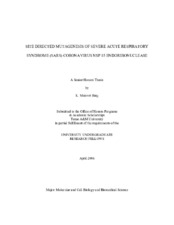| dc.description.abstract | ABSTRACT
Site Directed Mutagenesis of Severe Acute Respiratory Syndrome (SARS) Cornavirus Nsp 15 Endoribonuclease (April 2006)
K. Maravet Baig
Department of Biology
Texas A&M University
Fellows Advisor: Dr. Linda A Guarino
Department of Biology, Biochemistry, and Entomology
In 2002-2003 SARS Coronavirus (SARS- CoV) spread throughout the world resulting in a 10% death rate. With little known about SARS-CoV, research must be done in order to understand the viral mechanism for structure based drug design in the future. The purpose of this research is addition to the current body of knowledge concerning SARS-CoV proteins, especially that of the Nsp15 endoribonuclease and its activity.
Nsp15 is a non-structural protein of SARS-CoV with endoribonuclease activity. Nsp15 recognizes and cleaves at uracil with a Mn2+ cofactor; (Endoribonucleases cut in the interior of RNA strands). It was hypothesized that the uracil recognition may be indicated by four conserved asparagine residues. To test this, one of the conserved asparagine residues was mutated for analysis.
Site directed mutagenesis of Nsp15 with a QuickChange kit was performed. The 4th asparagine, N, was mutated to alanine in one sample and to serine in another sample, making N4A and N4S mutants respectively. The 4th amino acid was chosen due to the flanking amino acid’s known ability to affect activity. Nsp15 forms a hexamer, if the mutation caused the hexamer conformation to be disrupted, activity would be affected.
N4A and N4S mutant proteins were created, and their catalytic activities were tested. N4F, another mutant protein was tested, where phenylalanine replaced asparagine in the 4th amino acid position. Dilutions of the three mutants were tested in order to compare the mutant activity with the wild type Nsp15 activity. N4S and N4A showed activity, but the N4F mutant did not.
Since N4F had no activity, it was inferred that the mutation caused a conformational change in the protein thereby affecting activity. Since hexamerization is protein concentration dependent, different concentrations should be tested in order to find out if the protein is active at higher concentration, or if it forms hexamers. A determination of the binding affinity of the mutant Nsp 15 for the known co-factor Mn2+ should also be conducted as well as the examination of conformational changes brought about by addition of Mn2+. Lastly, failure to bind the RNA substrate may cause inactivity; this possibility should also be tested. | en |


